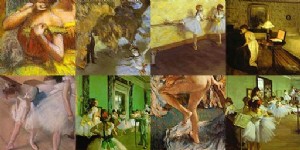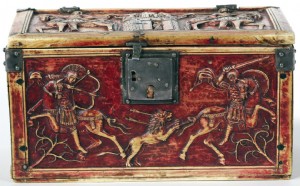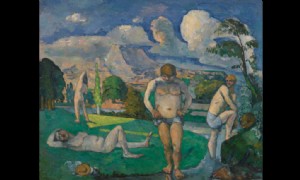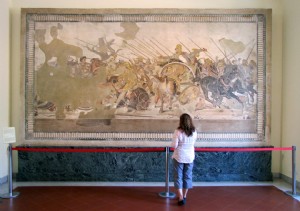Henri Russo (1844-1910)
Como muitos gênios que estavam à frente de sua era, Henri Rousseau não soube durante sua vida, nem fama nem riqueza. Um artista talentoso, que trabalhou até os 41 anos como escriturário comum na alfândega de Paris, encontrou força de vontade para abandonar seu modo de vida habitual e se dedicar totalmente à pintura. A única coisa que apoiou Rousseau em seu hobby foi uma fé inabalável em seu próprio talento, o que lhe permitiu se tornar um dos maiores mestres de sua época. Surpreendentemente, o desejo de imitar as técnicas do passado transferiu o artista diretamente para o futuro - seu jeito criativo se tornará muito característico de muitos mestres do século XX. A arte “ingênua” de Russo, acompanhando o ritmo do impressionismo, logo se separou em uma escola completamente diferente. O estilo original do pintor, repleto de elementos de fantasmagoria, foi admirado por Pablo Picasso e Robert Delaunay, dando a Rousseau apenas meios mínimos de subsistência durante sua vida.
Juventude tempestuosa
Iniciando sua carreira como artista aos 41 anos, Henri Russo foi autodidata. Chegando das províncias de Paris e se estabelecendo como funcionário de pequeno porte, Rousseau pintou em todos os lugares:enquanto em serviço no trabalho, aproveitando o favor de seus superiores, e à noite em casa. Pobre, mas paciente, modesto, mas confiante em seu gênio, ele se tornou um dos principais e mais reconhecidos mestres da vanguarda artística, que foi admirado por contemporâneos progressistas e gerações de descendentes.
Uma vez que o próprio Rousseau escreveu uma nota autobiográfica para o livro “Retratos do Próximo Século” - “Nasceu em Laval em 1844 em uma família com uma renda modesta e desesperada, ele foi forçado a se dedicar à profissão errada, o que o atraiu ao seu amor pela arte. ” Verdade, o livro nunca saiu.
O pai de um artista autodidata foi Julien Russo - um funileiro hereditário de uma cidade no oeste da França - Laval. E sua mãe é filha de um oficial do Grande Exército de Napoleão. O pai de Henri queria desesperadamente ficar rico, Portanto, tendo comprado uma casa na periferia da cidade, ele deixa seu ofício como funileiro e tenta estabelecer um negócio de revenda de vários produtos. Mas, ai, seu trabalho está queimado, e desde então uma pobreza sem esperança instalou-se na casa de Russo.
Felizmente, apesar da extrema necessidade, a família do futuro artista conseguiu enviar seu único filho para estudar primeiro na escola, e depois no Liceu. Henri era um estudante mediano, embora ele tenha conseguido vários prêmios escolares, distinguindo-se no canto e na aritmética. Essas conquistas aparentemente insignificantes são observadas em toda parte em sua biografia, não porque Rousseau se tornou um artista mundialmente famoso, mas porque ele também escreveu uma valsa incrível que leva o nome de sua primeira esposa - “Clemence”.
Após o treinamento, Henry consegue um emprego no escritório de advocacia, onde ele comete um grande erro. Aos dezenove anos, instigado por seus amigos, Rousseau rouba uma pequena quantia de dinheiro do departamento de contabilidade, mas isso é suficiente para encerrar a carreira de seu advogado e entrar em investigação. Em corte, Henry tem que concordar com um acordo - até sete anos de serviço militar, por apenas um ano na prisão.
O Regimento Russo, estacionado na França, nunca participará de hostilidades no exterior. Mesmo quando Napoleão III envia o corpo militar francês ao México para apoiar seu protegido Maximiliano na luta pelo trono imperial, a futura vanguarda não participa da expedição. Embora, muito tarde, o poeta Guillaume Apollinaire (1880 - 1918) escreve um poema sobre a estadia de Rousseau no colorido país asteca, o artista nunca tenta refutá-lo, bem como vários outros mitos sobre sua vida.
Em 1868, o pai de Rousseau morre, e Henry, como o único ganha-pão da família, recebe demissão do exército. Tendo deixado seu regimento, que estava localizado em Paris, ele mergulha de cabeça na vida agitada da cidade grande. Em primeiro lugar, o jovem encontra trabalho e tira sua vida, localizado não muito longe de Le Bon Marche, o primeiro shopping center de vários andares da capital francesa.
O jovem imediatamente se apaixona pela filha da dona da casa, Madame Buatar. Em 1869, ele toma Clemence Buatar como esposa. Apesar da fraqueza constante (Clemence estava doente com tuberculose), o cônjuge ajuda Henri a ganhar dinheiro para o resto da vida, incansavelmente costurando por encomenda. Nos fins de semana, os amantes costumam caminhar nos belos parques parisienses. Verdade, a felicidade de Henri e Clemence é ofuscada pelo fato de seus filhos morrerem um após o outro na infância.
Dos sete filhos de cônjuges amorosos, apenas dois sobrevivem - a filha de Julie-Clemence e o filho de Henri-Anatole. Esposa de Russo, constantemente atormentado pela tuberculose, estava muito fraca para cuidar das crianças sozinha, portanto, desde o nascimento, foram criados por uma babá que morava em um subúrbio de Paris. Em 1888, Clemence morre. Henri Russo nunca esquecerá sua amada esposa. Mesmo durante sua vida, ele dedicaria a ela uma valsa de sua própria composição, e depois de sua morte ele criará continuamente seus retratos.
Arte viva oficial mesquinha
Em 1871, o jovem Russo conseguiu um emprego permanente na alfândega do Departamento de Impostos, que no século 19 arrecadava impostos de mercadorias importadas para Paris. A inspeção de mercadorias nas portas da cidade é uma ocupação enfadonha e monótona, mas não limita a liberdade interior da pessoa que o executa.
Durante um dos próximos turnos, um pequeno escriturário monta um cavalete bem no pátio do prédio do departamento, e começa a desenhar. Infelizmente, as pinturas pintadas por Russo até 1877 não sobreviveram. A exceção é apenas uma, retratando uma cena de batalha contra o pano de fundo da paisagem local.
Breve, o então famoso artista Felix Clement (1826 - 1888), que ajudou o jovem Russo com conselhos, apresenta o aspirante a pintor a um dos representantes da arte oficial francesa da época, Baron Leon Jerome. Depois disso, Rousseau alugou sua primeira oficina e em 1885, apoiado pelo barão, expôs pela primeira vez duas de suas obras no Salão dos Miseráveis.
Um ano depois, em 1886, o artista Paul Signac (1863 - 1935), interessado na obra de Henri Russo, o convida a participar de uma nova exposição. Signac considerou que o melhor lugar para as obras de um pintor tão original era no Salão de Artistas Independentes, criado por representantes da arte de vanguarda. O fato é que todas as primeiras tentativas de criar salões independentes terminaram em fracasso - como por mágica, eles começaram a se parecer com o salão oficial, o que não agradava aos pintores progressistas que sentiam uma necessidade cada vez maior de serem exibidos separadamente.
Para Rousseau, era óbvio que os círculos de arte oficiais representados pelo Salão, com sua velha tradição acadêmica, teria rejeitado para sempre o autodidata, pelo menos do princípio. Portanto, daquele tempo até o fim, Henri Russo permanecerá fiel ao novo "salão sem júri".
Já em 1886, tendo exposto quatro de suas obras em um salão independente, o aspirante a artista será altamente apreciado por pintores famosos como Paul Gauguin (1848 - 1903) e Puvi de Chavannes (1824 - 1898), que ficaram encantados com a capacidade de Rousseau de transmitir momentos dramáticos com a ajuda de muitos tons de preto. Mas, em geral, suas obras permanecem incompreensíveis para o público, ainda mais - são ridicularizados - os acadêmicos afirmam que até uma criança é capaz de desenhar assim.
Felizmente, Rousseau era muito resistente ao sarcasmo e às críticas do público. Ele até conclui um acordo com Argus, de acordo com o qual todos os artigos e recortes de jornais foram enviados a ele, que continha resenhas e comentários sobre seu trabalho. Em antecipação ao reconhecimento universal de seu talento indiscutível, o artista colou pedantemente em um caderno, que eventualmente se tornou mais espesso. É pelos jornais que Russo fica sabendo que a Prefeitura de Paris lhe concedeu uma medalha. Feliz, ele imediatamente ordena mencionar o prêmio em seu cartão de visita, mas depois descobri que ele estava com pressa:tratava-se de outro artista com o mesmo nome.
Preocupado com a morte de sua esposa em encontrar fundos para o sustento normal dos filhos e comprar tintas, Rousseau, na esperança de ganhar dinheiro e ficar impressionado com a Exposição Mundial de Paris em 1889, em que a França apresentou sua famosa Torre Eiffel, o artista novamente se volta para a música e escreve o libreto para o vaudeville. Infelizmente, não rendeu um centavo.
Depois de se aposentar do serviço em 1893, depois de anos de serviço, Rousseau recebe uma pensão escassa e só pode sonhar com o tempo em que seu passatempo favorito - pintar, vai finalmente começar a trazer uma renda decente. Enquanto isso, Russo é forçado a dar aulas de violino e desenhar pinturas por encomenda, vendendo-os a preços ridículos. Embora, apenas um ano depois, seu trabalho “A Guerra”, exibido no Salão dos Independentes, obtém uma ampla resposta, em particular, o escritor Alfred Jary (1873 - 1907) a admira, com cuja luz, o artista Henri Russo recebe o apelido de “funcionário da alfândega” (Le Douanier), fixada nele para o resto da vida.
Breve, toda a família Russo se muda, quem está onde. Em 1895, a filha do artista sai com o marido em Angers, localizado no oeste da França, e o pintor muda-se com seu filho Henri-Anatole para viver em Montparnasse - a famosa área na margem esquerda do Sena, que mais tarde se tornou um ponto de encontro favorito para a vanguarda artística e intelectual. Lá, em Montparnasse, Rousseau conhece Josephine Le Tensorer - uma mulher que morava no bairro e que conquistou o coração da artista. Por muito tempo, Josephine negligenciou as confissões de amor do pintor e concordou em se tornar sua esposa somente após a morte prematura de Henri Anatole.
Como um maçom amante da liberdade, Henri Russo ainda se casou na igreja com seu novo amor em 1898. A situação financeira da família era deplorável, Portanto, para ajudar seu marido, Josephine tentou vender seu trabalho em sua loja de materiais de escritório, e o artista, por sua vez, continuou a dar aulas remuneradas. No entanto, nos domingos, Rousseau, apesar de sua necessidade, no quadro da Sociedade Filotécnica, cujo objetivo principal era educar as massas, ensinou a todos que queriam pintar em aquarela, pastel, e também, com orgulho e prazer, compartilhou sua experiência em pintura de porcelana e cerâmica.
Beggar Genius
Apenas cinco anos depois, em 1903, o pintor fica viúvo pela segunda vez, e, tentando lidar com a dor, ele se dedica totalmente ao trabalho. Devo dizer, sua carreira como artista, finalmente começou a ganhar impulso rapidamente. Em 1903, voltou a participar em dois salões de arte - Artistas Independentes (em março) e no primeiro Salão de Outono, que foi inaugurado em outubro. Mas o pintor ainda está em extrema necessidade. Felizmente, a modesta mas generosa família papua, que morava no bairro, frequentemente o convidava para o jantar, e amiga Marie Bisch, que está envolvido no comércio de pequena escala, mais de uma vez ajuda Russo em situações financeiras críticas.
O ponto de viragem ocorre apenas em 1906, quando o artista conhece Robert Delaunay (1885 - 1941) e o poeta Guillaume Apollinaire. Novos amigos admiram abertamente o talento do pintor, e Pablo Picasso (1881-1973), tendo acidentalmente adquirido o Retrato de uma Mulher de Bris Henri Russo em 1908, organiza um magnífico banquete em homenagem ao autor.
Um dos amigos de Picasso, Fernanda Olivier, descreve Rousseau:“Este respeitável, homem ligeiramente curvado que tem mais probabilidade de correr do que andar, seu cabelo é grisalho, mas espesso, apesar de sua idade, tem os hábitos de um pequeno locatário, e seu rosto está um pouco assustado, mas gentil. Ele corava facilmente quando ficava envergonhado ou quando alguém se opunha a ele. Ele concordou com tudo que foi dito a ele, mas parecia que ele se mantinha indiferente e simplesmente não ousava expressar seus pensamentos. ”
Entre os amigos de Rousseau estava Alfred Jary (1873 - 1907), o artista o conheceu no momento em que a última obra - “Rei Ubu” (1896), o que o tornou o famoso fundador do teatro do absurdo, ainda não foi escrito. Talvez seja precisamente a paixão pelo choque e pela provocação que aproxima Rousseau e Jary. De acordo com o jovem escritor, a arte ingênua do oficial da alfândega, franco e intransigente, chocando o homem comum. Uma vez, Zhari encomendou ao pintor seu retrato. A imagem, Infelizmente, não chegou aos nossos dias, mas sabe-se que Russo retratou seu amigo com um camaleão e uma coruja. Fry ficou encantado! Ele paga a Rousseau o dinheiro da herança dos pais e em todos os lugares exalta seu talento. O artista acalentou essa amizade. Foi ele quem estendeu a mão e abrigou o jovem excêntrico quando a sorte o mudou em 1897, e Zhary, sem um tostão no bolso, acabou na rua.
Henri Rousseau teve um claro, voz infantil, todos o consideravam ingênuo e simples, mas foi realmente assim? A confiança inabalável em seu próprio gênio permitiu que o pintor se tornasse uma pessoa determinada com uma resistência extraordinária, e uma ingenuidade quase infantil - um artista muito original.
Em dezembro de 1907, Rousseau, devido ao seu descuido e credulidade, novamente fui para a prisão por fraude, Apesar, na verdade, ele era sua vítima. Para ter liberdade, nem que seja para dar aulas de caridade aos domingos, o artista escreve uma petição ao Tribunal:“Voltando-se para a sua bondade, Peço pelo menos liberdade condicional para poder continuar trabalhando. Eu imploro que você não destrua minha carreira, para o qual trabalhei tanto. " Felizmente, O pedido de Rousseau foi atendido após as férias de Natal.
Truques amigáveis
De acordo com contemporâneos, Rousseau geralmente trabalhava com uma camisa branca de linho simples, mas sempre veste um terno quando organiza recepções em sua oficina. O colecionador alemão Wilhelm Ugde, o primeiro a dedicar um livro inteiro ao artista em 1911, era um dos frequentadores regulares das festas dos funcionários da alfândega. Aqui está como ele descreveu a rua onde a casa de Rousseau estava localizada:“Tem apenas alguns passos de comprimento e, em seguida, repousa contra uma parede de pedra. Parece que estamos em algum lugar da província e não em Paris. Nos quartos do rés-do-chão o proprietário vive com a família, e acima estão os apartamentos dos hóspedes. Em uma das portas, há uma placa - “Lições de retórica, música, desenhando, solfeggio ”. Ligamos e entramos:Russo nos encontra. ”
Quase todo sábado à noite, entre suas pinturas e amigos, o oficial da alfândega toca violino para artistas, colecionadores e apenas amantes da arte. Ele esta apaixonado de novo, mas Leonia, uma viúva de 59 anos, se recusa a se tornar sua esposa. Nessas noites, muitas vezes era possível encontrar o dono da casa onde Rousseau morava - o Sr. Keval, um homem quieto e respeitável que era colega de Russo para trabalhar na alfândega de Paris. Entre os convidados muitas vezes era possível ver Ambroise Vollard, que comprou quadros do artista e o convidou com ele mais de uma vez para festas artísticas. Henri Rousseau estava em um surto emocional:finalmente era hora de provar os frutos de muitos anos de trabalho duro - uma situação financeira estável, reconhecimento universal. Isso é apenas saúde ... O pintor há muito sofre com feridas não cicatrizadas nas pernas, que, no fim, causou gangrena.
Um artista brilhante, Henri Russo morreu em 2 de setembro, 1910 no Hospital Municipal Necker em Paris. Ele foi enterrado em uma vala comum. Robert Delaunay, Ambroise Vollard e Paul Signac vieram ver o artista em sua última jornada.
Um ano depois, Delaunay organiza às suas próprias custas um enterro dos restos mortais do artista. E Guillaume Apollinaire escreverá em sua lápide um epitáfio composto por ele:“Adeus, nosso bom amigo Russo! Ouça-nos - Delaunay com sua esposa, Keval e eu. Vamos trazer pincéis, tintas, e tela como um presente, para que você pinte retratos de estrelas em seu santo lazer. ”
Trabalho cedo
Olhando para as primeiras pinturas de Henri Russo, um dos críticos dirá:"Ele é sincero e ingênuo, algo que lembra os primitivos. "O segundo crítico concorda:" Esta pintura é bastante seca e dura, mas muito interessante, porque sua ingenuidade leva à ideia de primitivistas italianos. "Mesmo zombadores e oponentes fervorosos da obra original de Rousseau reconheceram o mestre como um primitivista notável.
Embora as telas sejam “Caminhando pela Floresta” e “Encontro na Floresta”, o pintor está ainda mais próximo da pintura nacional da era rococó do século 18 do que dos primitivos italianos. Isso se deve em grande parte ao motivo tradicional claramente visível de cenas galantes (fetes galantes), muito característico do artista francês Antoine Watteau (1684-1721), cujas pinturas foram exibidas no Louvre. A propósito, eram suas reproduções que adornavam as paredes da oficina Russo.
As obras do período inicial em Rousseau o distinguiram muito de seus contemporâneos - os impressionistas. Isso pode ser visto claramente no sofisticado esquema de cores das pinturas “Encontro na Floresta” e “Caminhada na Floresta”, em que o pintor retrata árvores reais e imaginárias usando um grande número de diferentes tons de marrom e verde.
Na primeira imagem, a floresta é densa e intransitável, no segundo - leve e transparente. Todos os planos de longo prazo são feitos de forma vaga, pequenos golpes, o que facilita a percepção visual, neutralizando uma floresta escura muito saturada. O céu, ocupando um terço da imagem, árvores deliberadamente reduzidas à distância - tudo isso fala da tentativa do artista - autodidata para de alguma forma determinar os limites do espaço, dê profundidade, isso é, para mostrar a perspectiva de que, para Rousseau, privado de conhecimentos e habilidades acadêmicas, foi um verdadeiro obstáculo. Talvez seja por isso, mais tarde, ele abandonou deliberadamente qualquer perspectiva em suas telas.
A pintura “Encontro na Floresta” retrata amantes cavalgando e olhando um para o outro. Eles estão vestidos com trajes típicos do século XVIII. O cabelo comprido da mulher está solto livremente sobre os ombros - um motivo que está presente em muitas imagens femininas da escova de Rousseau. A força dos sentimentos, abraços mútuos, a ternura no olhar do homem cria um efeito claro da presença deste casal na tela, apesar do fato de seus corpos serem praticamente invisíveis por trás da vegetação exuberante. Amando apenas em seu próprio mundo, eles apareceram por um curto período de tempo atrás da floresta, e parecia que estavam prestes a desaparecer de vista para sempre novamente.
Na tela “Caminhando pela Floresta”, vemos uma mulher muito parecida com Clemence, ela pareceu congelar - talvez ela estivesse assustada com os ecos da cavalgada, o alarmante farfalhar de folhas ou o súbito estalar de um galho.
Imagens femininas
Imagens femininas, bem como imagens de animais, ocupou um lugar enorme no trabalho do artista. Dois grandes retratos femininos, pintado por Rousseau com uma pequena lacuna, são composições muito semelhantes. Ambos retratam mulheres de preto em pé de corpo inteiro. O formato das obras e as poses dos personagens permitem atribuir as pinturas ao gênero de retratos de desfile. Talvez ambos tenham sido feitos sob encomenda, embora a identidade dos modelos permanecesse desconhecida.
A primeira tela - “Retrato de uma Mulher” (nome alternativo “Retrato da Sra. M.”) foi criada por volta de 1895. Foi esta pintura que foi adquirida por um preço muito modesto em 1908 por outro artista brilhante - Pablo Picasso (1881 -1973), que estava muito entusiasmado com isso. Este trabalho também é conhecido como Jadwiga, embora não haja evidências de que o nome do modelo corresponda.
Diz a lenda que a rapariga da tela era uma bela polaca que encantou o pintor. E embora esta versão não tenha evidências, o fato permanece:Rousseau gostou desse nome. Ele mesmo os chamou de protagonistas da peça de sua própria composição - “A Vingança do Órfão Russo”. Talvez tenha sido ela quem encarnou para o artista certa imagem da mulher ideal. Com o mesmo nome, o mestre chamará a heroína de sua outra tela - “Sonho” (1910).
A composição do primeiro retrato lembra uma fotografia encenada de uma loja da época. Uma figura feminina está em uma varanda cheia de vasos de flores contra uma cortina enorme, rodeado por uma paisagem fantástica. Nas mãos de Jadwiga está um galho de árvore. Este detalhe é de particular interesse por ser um símbolo tradicional de morte. Isso pode ser explicado, se você acredita nos defensores da teoria da existência real desta mulher, que afirmam que no momento da escrita da tela Jadwiga já estava morto. Essa suposição é indiretamente confirmada pelo fato de que a artista escolheu a cor preta para o vestido da mulher, que sempre enfatizou a natureza dramática especial da cena retratada.
A mulher do segundo retrato é retratada em meio a uma variedade excitante de vegetação. Sua mão repousa em sua coxa, e suas pernas saindo de baixo do vestido mal tocam o chão, que cria a ilusão de movimento. Na parte inferior da tela, vemos um gatinho brincando com uma bola de linha, trazendo vivacidade e espontaneidade ao tom oficial do retrato.
Russo termina sua famosa obra “The Sleeping Gypsy”, também dedicado à imagem feminina, apenas um mês após a morte de seu único filho, Henri Anatole.
Em 1897, ele expôs o trabalho no Salão dos Independentes, acompanhando-o com uma legenda escrita na moldura:"Um predador, oprimido por uma sede de sangue, congela no lugar, não ousando atacar uma vítima profundamente sonolenta. "A figura da cigana com seu lenço e roupas coloridas, contrastando fortemente com a pele escura, lembra um pouco as mulheres orientais de pinturas de artistas acadêmicos. Foi esse trabalho que Russo propôs ativamente adquirir as medidas de sua cidade natal de Laval, em memória de si mesmo.
O artista ainda escreveu ao prefeito da cidade:"Tudo é banhado pelo luar aqui." Claro, a prefeitura rejeitou sua oferta. A obra desaparece e é redescoberta apenas em 1923 e, uma vez que nem todas as pinturas de Rousseau eram amplamente conhecidas, causa muita polêmica e rumores. Muitos consideram isso uma farsa, uma piada, que foi atribuído a outro artista - Derain. Aqueles que não duvidaram da verdadeira autoria da pintura, considerou-o como um passo muito decisivo do pintor do realismo ao surrealismo.
Breve, Rousseau se afastou dos impressionistas, embora ele ainda compartilhasse sua antipatia pelos cânones tradicionais das belas-artes. O impressionismo implicava a liberdade criativa tão necessária para Rousseau. Sua arte, com base em uma interpretação completamente plana de todas as formas, não só não leva em consideração as regras padrão de representação de perspectivas adotadas na Renascença, but also consciously neglects them. The artist simplifies the form, creating his own unique style of painting. The real proportions are distorted here, the color elaboration of the volume is absent, and the shadow does not exist at all. Rousseau did not want to portray boring and mundane reality, passing through his rich imagination all images and forms.
The artist’s art strongly resembles decorative painted pictures with multi-colored figures of smooth texture and unpretentious shape. His painting "The Child with the Puppet" makes a strange impression that makes one shudder. The master first delineates the contours of the figure of a child resembling a porcelain doll, leaving it itself unwritten, then works on the background of the picture and returns to the figure again. Rousseau, like Emil Bernard (1868 - 1941) and Paul Gauguin, completely ignores the principles of classical perspective. Além disso, the painter gives a clear preference to substantive conventions, rather than boring specifics.
Children’s portraits
Brushes Russo own many children’s portraits. It is not known why the theme of children was so important for the artist, if they were custom-made works, if the artist felt the loss of his six children. The exact answer to this question is unknown, we can only assume that, portraying children, the painter tried with the help of paints, brushes and imagination to bring back to life the images of his loved ones. Many of Rousseau’s portraits of children are in large format.
Por exemplo, a child in a red dress looks so large that it feels as if his figure hardly fits on the canvas. Pelo visto, the child is sitting:legs bent at the knees and almost hidden in the grass speak about this. The figure itself seemed to hover between heaven and earth, which imperceptibly smoothes the feeling of excessive massiveness. Like “The Child with the Puppet, ” the kid in this picture also holds a strange doll in his hand, resembling an adult with facial features.
In another picture of the same period - “Peasant Wedding”, we see a bride who looks at us with humble reverence. The figures of the people around her are so flat that they seem to be separately cut out of colored paper and glued to the background landscape. Even in spite of the trees carefully arranged by the letter “V” and some awkward dog located in the foreground, which theoretically should have been a compositional designation of the perspective, they could not erase the collage impression made by this painting.
The bride’s figure is the undisputed dominant of the picture, it is she who, with her snow-white belt, seems to connect the remaining characters into a single group. On the canvas, the artist symbolically indicated the continuity of generations, with the help of a long veil of the bride, slightly covering the elderly woman sitting nearby, who is obviously the grandmother of the bride or groom. The figure of an old man sitting separately from the group of main characters, whose legs are hidden in the grass, conjures up thoughts about the connection between modernity and eternity, life and death, earth and sky. The solemnity with which the whole group is located under the trees again reminds of a 19th century shop. It was in such static poses that people froze in front of a photo lens against the background of painted flat scenery:“We don’t move! Do not breathe! ". It’s possible that while working on the “Wedding”, the painter drew inspiration from some photograph, but nothing is known about the reasons for his appeal to this topic, as well as about the personalities of the prototypes of the characters. Although the man standing to the right of the bride remotely resembles the artist himself.
Symbolic works
In 1906, Henri Rousseau presented to the public his new work - “Freedom, calling for painters to participate in the 22nd exhibition of Independent Artists”, que, even being in the exhibition of the Salon of Independents, causes visitors to laugh only. Only a close circle of friends admires the new work of the artist, while the rest can not understand either the design itself or the ways of its implementation.
Friend of the painter - Robber Delaunay exclaims:“In another era, he would have painted the walls of the palaces by order of patrons. In ours, he is forced to be a jester for the inhabitants, he is so serious, so calm. What a senseless irony of fate! ” Russo celebrates the Salon with his new work, which made him a full-fledged artist, in every sense of the word. The compositional center of work is the allegorical figure of Liberty, depicted in a manner reminiscent of the academic. She plays the trumpet, traditionally a symbol of worship.
A year later, Rousseau again amuses the audience in the Salon of Independents with his work “Foreign representatives arrived under the banner of peace to salute the Republic”. On the canvas, we recognize the six presidents of the French Republic (dressed in black) standing on the podium, the Russian emperor (in a yellow and blue uniform), the king of England (on the left side), and also on the right:Franz Joseph from Austria, Peter I from Serbia, William II from Germany, Leopold II from Belgium, George I from Greece, the Persian Shah and King of Ethiopia. The republic, in red robes and a Phrygian cap (the headdress of the era of the French Revolution of 1789) triumphantly rises above all, holding an olive branch in outstretched hand. This multicolored extravaganza, colored by foreign flags, passes under the slogan written on three black pedestals standing in the foreground of the canvas:“Work, freedom, equality. ” And in the background we see people gathering in a circle to start their holiday dance.
The artist was very fond of allegories, so popular among representatives of political circles. Repeatedly Rousseau took part in various competitions, which from time to time are arranged by the Paris authorities in order to decorate the premises of various departments. The painter always wanted to receive an official order, well paid and prestigious, Porque, firstly, he constantly felt the need for money, and, em segundo lugar, he still dreamed of universal recognition.
Contudo, the Customs Officer has failed to conquer either one or the other. Além disso, all the time there were people who used this artist’s weakness and his inherent naivety to repeatedly play poor Rousseau. It even came to the point that the painter almost went to the Champs Elysees to personally thank the President of the French Republic for awarding him with his main state award - the Order of the Legion of Honor, the award of which was announced to the artist by evil jokers.
Exotic India
Once, the mother of the artist Robert Delaunay, succumbing to the entreaties of her son, decided to order a Russo painting. Her stories about an exotic trip to India inspired the Customs Officer to create a canvas designed in rich green tones typical of the tropical jungle. In the center of the picture we see the figure of a black-haired woman - a snake charmer, who is very reminiscent of an ancient mystical deity. Black snakes, as if mesmerized by the magical sounds of her pipes, slowly creep out from everywhere, and if at first glance they are barely distinguishable, then when the look gets used to a variegated variety and begins to distinguish details, you see them more and more. Amazingly, their movement on the canvas is felt almost physically. The eyes of the female figure, which are the only bright spot in the picture, add a mystical shade to the canvas, their tremendous attractive power is striking.
A river illuminated by a full moon, a thick and mysterious veil of plants shimmering in all shades of green, an exotic pink bird, brightly shining yellow flowers - the whole scene exudes incredible paradise and tranquility. The vertical lines of the figure and the plants surrounding it are softened by horizontal rays of light coming from the month. This fundamentally distinguishes the composition of “The Enchantress” of Rousseau from his “War”, where the horizontal construction of the entire canvas creates the effect of decay and symbolizes destruction and destruction.
Unpleasant Surprise is somewhat close to Snake Charmer. In this picture we see a woman scared by a bear. The figure of the woman again resembles the mythical goddess, or Old Testament Eve, lost in the Garden of Eden. Her round hips are slightly covered by hair falling down to her knees. As in The Caster, the woman is surrounded by the same bizarre trees with bright foliage, and in the background - on the shores of a magical lake, depicting dense forests of bizarre trees. And in the depths, the figure of a lurking hunter is hardly noticeable. When you see her, the soul becomes calm - he will certainly shoot and save the woman from the predator.
Contemporaries will write down a statement by an Italian critic dedicated to Rousseau:“He lives in a strange world, fantastic and real at the same time, close and far, sometimes funny, sometimes tragic. He loves a riot of colors, fruits and flowers, wild animals and fabulous birds. He lives, working unconscious, focused and patient, met with ridicule and unfriendly shouts every time he decides to break his loneliness in order to present his creation to the world. ”
Buddy portrait
The hero of the picture “Chaise of Father Juniet” (1908) is a real character - a seller of vegetables, a former friend of Rousseau (though his real name was Claude Junier). His shop on Montparnasse was located just a few meters from the painter’s workshop. Junier always helped an artist who often lacks money for products. Sometimes Junier, along with his friends, took Rousseau to ride on his chaise, which served him for the transport of goods. Juniera’s pet - a mare Rosa pulled a chaise. The seller of vegetables had a great weakness for horses and dogs, one of which is shown in the picture next to the chaise.
When creating the canvas, the artist used a photograph taken in Klamar in 1908. Rousseau transferred the composition of the photograph to the canvas, adding to it a dog on the road and several figures. While the painter was working on the painting, his workshop was visited by the American artist Max Weber (1881-1961). Considering the work, Weber drew the author’s attention to the imbalance in size between dogs and other objects and characters. Rousseau replied:"Everything must remain as it is."
Perhaps the artist is right, relying only on his own vision, because when you look at this work for a long time, it starts to seem that it is this absolutely disproportionate, and therefore some mysterious dog that gives the picture a touch of fabulousness. It is the altered proportions and disturbed perspective, abundantly supplemented by elements of phantasmagoria, that give Rousseau’s everyday scenes this element of attractiveness and mystery.
Five people and a dog are sitting in a chaise. All of them are depicted facing the viewer, as if lined up in a line, like a group from the canvas "Peasant Wedding", but at a clear angle with respect to the seats of the chaise and the direction of the road. The canvas has an impressive size, very characteristic of works of decorative art, and this, according to critics, makes it similar to the "tapestries of a thousand flowers" - magnificent carpets popular in the 15th century on which colorful ornaments were woven from fancy plants.
Pela primeira vez, the artist uses an absolutely smooth canvas in the painting, thanks to which the strokes are almost invisible. The whole color of the picture is clearly divided into two scales:black, white and red in the foreground, and ocher, green and blue - on the "backdrop".
City landscapes
Less well-known but no less significant part of Rousseau’s creative heritage is urban landscapes. Numerous types of Paris and its suburbs were in high commercial demand, Portanto, the artist, constantly constrained by the means, had to write them tirelessly. In those distant times, the outskirts of Paris were still little built up and literally buried in the pristine greenery of forests. The artist did sketches for future paintings immediately with oil paints, without using gouache or charcoal. He confidently writes from life, directly on canvas, only sketching from time to time.
Prescribing individual fragments in the open air with sweeping sharp movements of the brush, Rousseau completes the picture already in the workshop, carefully finalizing the details of each component. Two of the most famous examples of urban landscape in the work of Rousseau are the canvases “Furniture Factory in Alfortville” and “View from the Sevri Bridge”. On them, the painter depicted a free interpretation of the factory for the production of armchairs and chairs in Alfortville and one of the districts of Sevri on the southwestern outskirts of the French capital.
The Furniture Factory in Alfortwigle was written ten years earlier than The View from Sevri Bridge. When you look at the picture, the sky immediately catches your eye, with bizarre clouds on it. On the left is a river, and in the background is a bridge. But both elements are, em vez, of secondary importance. All the compositional construction of the painting comes from the wavy sidewalk, which unexpectedly creates the impression of the right perspective, rare for Russo’s paintings. The factory building itself strongly resembles a cardboard house from theatrical scenery, and figures of people around look unnatural. All this makes the scene very conditional, almost surreal.
A striking element of the picture is the figure of a fisherman in the foreground. Initially, his image was only a compositional necessity. Contudo, after the character was completed, the artist discovered that this fisherman, waiting for the bite, symbolizes a certain existence outside of time and space, thus embodying eternity in the picture. It is this distinctive approach to the depiction of time that sharply distinguishes Rousseau from the Impressionists, who were characterized by admiring a moment taken separately from life.
The compositional center of the second picture is the bridge over the Seine, which connects its wooded shores. The black and white boat, located in the foreground, is very expressive, its hull is strangely similar to the face of a man. Small figures of pedestrians merge with houses shaded by red foliage. Red and gray-green roofs perfectly match the gamut of the autumn landscape. A balloon, a hang glider and an airplane symbolize the three epochs of conquering the sky, which were often mentioned in the press of that time, and which Rousseau himself admired.
Sonhos
In 1910, Henri Russo creates his greatest masterpiece - the canvas "Dream", exhibited by him in the same year at the 26th Salon of Independents. All his friends and colleagues unanimously claim that the work is worthy of the best reviews. The poet Guillaume Apollinaire writes about her in one of his articles:“I think that this year no one dares to laugh. You can ask the artists - everyone is unanimous, everyone admires them, even this sofa in the style of Louis - Philippe, lost in a virgin forest. And they are right. ”
Russo supplies the work with the following comments:“Jadwig has a magical dream. She quietly fell asleep to the flute of an unknown seducer. When a month casts light on flowers and green trees, animais, and even predators, freeze, listening to the wonderful sounds of music. ” Andre Breton (1896 - 1966) will note, a few years later:“I am close to saying:this great canvas absorbed all the poetry and all the secrets of our time. It is characterized by the inexhaustible freshness of discoveries… "
The painting "Dream", which has become one of the last works of Russo, is considered the will of the artist. Intertwined, the plants create an illusion of space on the canvas, which is echoed by the whole color scheme of the picture. The feeling of depth is emphasized by iridescent shades of green. Monkeys frolic in bizarre branches, where bright exotic birds are seen everywhere, and below, under them, predators roam in the grass. Only a black musician stands in the thick grass and plays his flute, as if not noticing anything around. Both characters and plants are torn from real space, their characteristic form and their true condition, but they are all written out so carefully that they look incredibly plausible. As if anticipating his demise, Henri Russo leaves us a legacy of a true paradise.With his “Dream”, the artist illuminated the coming generation with the road to surreal art, ahead of his time.
In the same 1910, Rousseau painted another picture - “The attack of the jaguar on the horse”, bought later by the patron Ambroise Vollard. The artist himself was proud of the work. “Twenty-two shades of green!” - the painter proudly told the famous Italian critic Argendo Soffichchi, who came to him to look at a new work. Sofficchi was shocked by the picturesque manner of Rousseau. After drawing with a pencil all the contours of exotic plants, the artist applied various shades of green in separate strokes, prescribing each fragment several times, and carefully cleans the palette with each color change.
Among strangers
Despite the fact that Rousseau’s personal sympathies were always on the side of academic painting, he received recognition only among the most progressive contemporaries - avant-garde artists were his best friends all his life. The creative manner of the artist himself is attributed to primitivism, thanks to his original style and because of his love for Italian primitive artists, such as Fra Angelico (c. 1400 - 1455) and Giotto (1267 - 1337), who worked in the XIV and XV centuries, when the laws of a classical perspective had not yet been discovered, the absence of which would become a real hallmark of all of Rousseau’s work. “Only in 1885, after numerous disappointments, was I able to devote myself to art, studied myself, learned nature and took the advice of Jerome and Clement, ” says Henri Russo about himself.
In search of his own style, Russo worked a lot in the Louvre, creating copies of the masterpieces of the great masters of the past. The painter received permission to work in the famous museum thanks to his friend Felix Clement (1826 - 1888), quem, like Rousseau himself, was a self-taught artist. Mas, unlike the Customs officer, Clement was recognized and kindly by the authorities. He, the lucky winner of the Roman Grand Prix of the French Republic, was paid for accommodation and training in Italy. The intelligent Clement, a devoted friend and delicate adviser, never allowed himself to be ridiculed or mocked at Rousseau and his paintings. On the contrary, he always insisted that the artist remained faithful to his style and did not turn off the chosen road. Clement introduces the Customs Officer to Leon Jerome (1824 - 1904), who worked at that time on the artistic embodiment of the lofty scenes of ancient mythology and ancient Eastern plots. Jerome - the star of official art - belonged to a group of artists - pompiers, named for their pompous luxury inherent in their canvases and pretentious splendor, and for the characteristic headdresses of their ancient heroes, reminiscent of helmets of firefighters (pompiers).
With rare exceptions, such as Clement and Jerome, Russo’s friends belonged mainly to the circle of Independent Artists. It was the representatives of neo-impressionism, in particular Georges Cera (1859 - 1891) and Paul Signac (1863 - 1935), who were the first to recognize a brilliant and original master in Rousseau in 1886. Signac highly appreciated his talent as a colorist, and Camille Pissarro (1831-1903) was loudly admired by the artist’s works, recognizing that it was precisely “feelings in the first place”. Robert Delaunay, the former, together with his wife Sonia (1885 - 1979), one of the founders of abstract art, expressed their admiration for the artist.
Delaunay and Russo become friends, despite the fact that the Customs officer does not always penetrate the essence of the creative research of his friend. “Why did Robert break the Eiffel Tower?” - Rousseau’s sincere question regarding the painting by Delaunay led to the appearance of the legend about the Customs officer as a naive genius who never really understood the figurative techniques of avant-garde art.
The author of this, like many other legends about the artist’s life, was the modernist poet Guillaume Apollinaire. He created myths about Rousseau, passing through his poetic imagination the story of his life, and the artist, in turn, immortalized his image on canvas. Apollinaire described the process of writing his own portrait:“First of all, he measured my nose, boca, my ears, my forehead, my arms, my whole body and very accurately transferred all these measurements to his canvas, reducing it in accordance with the size of the frame. (…) I did not move, watching with admiration how anxious he was towards the work of his imagination, not allowing anyone and anyone to interfere in the creative process, so as not to disturb the harmony of the picture. And how mathematically accurately he depicted the figure of a man! If my portrait had nothing in common with my appearance, this would not have happened through the fault of Rousseau, but due to some annoying calculation error. Contudo, even those who are not familiar with me recognized me in the picture. ” In the role of the poet’s muse, the canvas depicts the artist and Apollinaire’s close friend, Marie Lorensen (1883 - 1956).
An evening in the history of art
Here is an example of one of the stories related to the life of Russo and his friends. One January evening in 1908, Rousseau and Apollinaire appeared in Bago Lavoir, where Pablo Picasso (1881 - 1973), an artist from Catalonia, set up his workshop in a small wooden house. The customs officer, wearing a soft felt hat, takes pride of place at the table, leaving outer clothing and a cane at the door. On the wall hangs the work of the self-taught artist "Portrait of Mrs. M." (that same mysterious "Jadwiga"). The wall itself is decorated with flags, lanterns and a large poster with the inscription "In honor of Rousseau." The guests present are all in high spirits, some have already visited the nearby tavern.
Apollinaire solemnly recites the ode he wrote for this evening:“We have gathered to honor you with wine, which pours Picasso. There is reason to drink, and we will drink and rejoice:“Long live Rousseau!” Around the table gathered:artists Georges Braque (1882 - 1963), Marie Lorensen and Andre Derain (1880 - 1954), writer Andre Salomon, poet Max Jacob (1876 - 1944) and two American women - the famous writer Gertrude Stein (1874 - 1946) and Alicia Toklas. Wine flows like water, Rousseau takes the violin and plays the waltz that he once wrote for Clemence. Then he comes to Picasso and quietly says in his ear:"We are the two greatest artists of the era." Then Apollinaire gets up again and reads a poem telling about Rousseau’s trip to Mexico invented by him:“Do you remember, Rousseau, the Aztec landscape? Forests where pineapples and mangoes grew, Merry monkeys, watermelon pulp, Race warmed the emperor Maximilian? "Your paintings come from Mexico, Where the burning sun and the riot of nature." An artist who has never been to this country does not even try to object, because today is the long-awaited day of his triumph.
Later, a friend of Picasso, Fernanda Olivier will argue that the festive reception in Bateau Lavoir was a joke, a hoax. Contudo, Andre Salomon writes in his memoirs:"In Bato Lavoir, we had only one task - we wanted to give Rousseau the holiday he deserved." This technique in Bato Lavoir was one of the key moments in the history of the development of modern painting:it was there that two generations of artists met, thanks to whom new art was born.
-
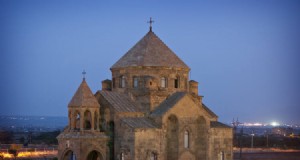 Catedral e Igrejas de Echmiatsin e o Sítio Arqueológico de Zvartnots
Catedral e Igrejas de Echmiatsin e o Sítio Arqueológico de Zvartnots
-
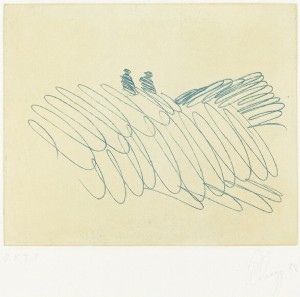 Figuras XI, 1988
Figuras XI, 1988
-
 Escola Francesa; anteriormente considerado flamengo - Coroação do Papa Celestino V em 1294
Escola Francesa; anteriormente considerado flamengo - Coroação do Papa Celestino V em 1294
-
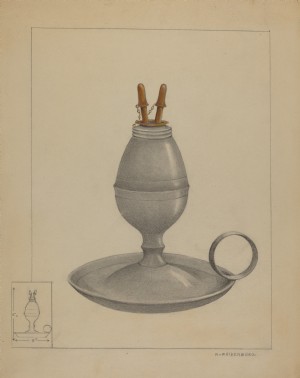 Lâmpada da câmara, c. 1936
Lâmpada da câmara, c. 1936
-
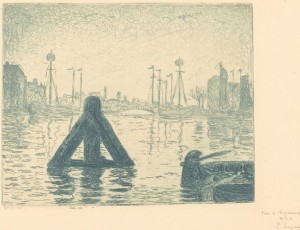 Porto na Holanda - Flushing (La balise - En Holland, Flessingue), c. 1894
Porto na Holanda - Flushing (La balise - En Holland, Flessingue), c. 1894
-
 Johannes Pistorius, 1504-1583, Teólogo [anverso], 1543
Johannes Pistorius, 1504-1583, Teólogo [anverso], 1543

